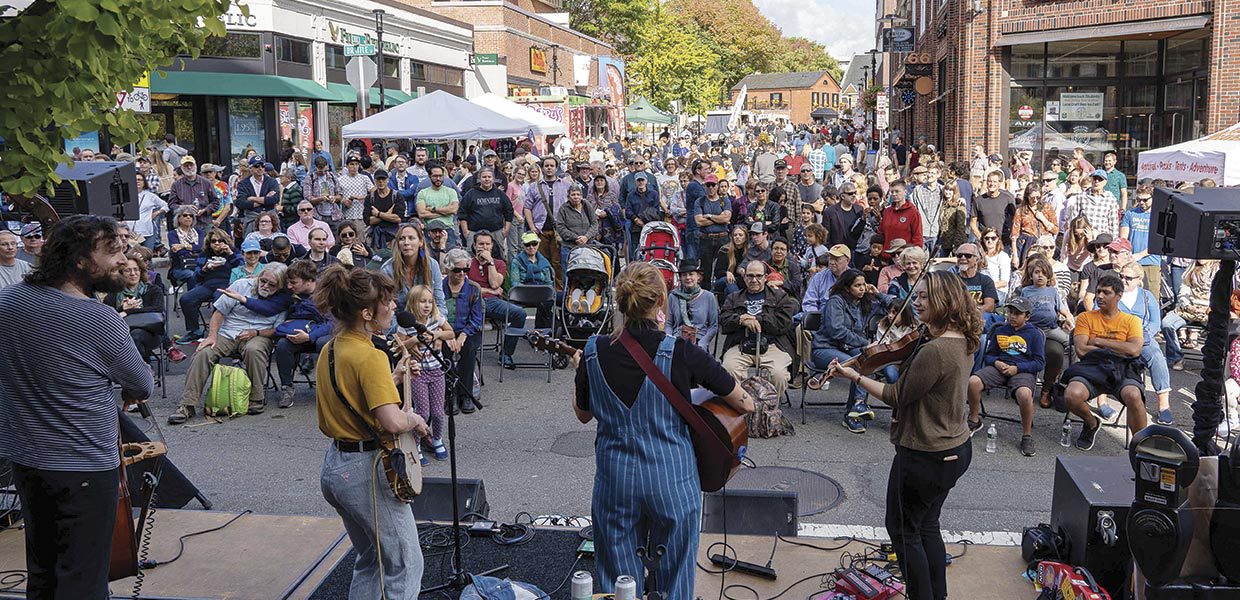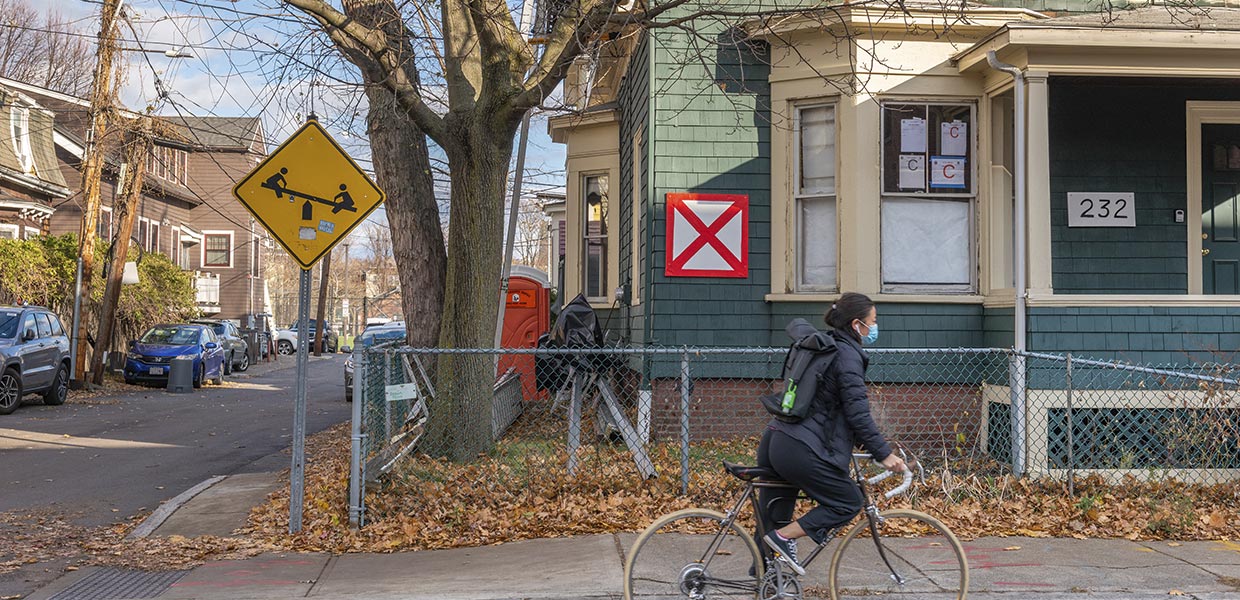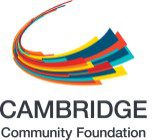Equity and Innovation Report
Chapter 4: Cambridge Close-Up
The Haitian folkloric dance company Jean Appolon Expressions in Starlight Square. (Photo by Lou Jones)
The Haitian folkloric dance company Jean Appolon Expressions in Starlight Square. (Photo by Lou Jones)
This fine-grained view of Cambridge reveals the impact of far-reaching economic change, as an old city dominated by venerable educational institutions becomes a new city with a cutting-edge economic base. In the case of Cambridge, the new has emerged from the old, with higher education in science, engineering, and advanced technology giving birth to industries that attract an increasingly young, mobile, and highly educated workforce. The ripples of this economic change can be felt well beyond the workplace, in the areas of income, housing affordability, racial makeup, and educational attainment.


of all income went to the top 5% of households

of renters in the first quintile spend half of their income on rent

in the middle quintile are between 25 and 34
Income
Among the most striking findings of this report are the income differences that mark Cambridge today. While the highest-income quintile accounts for 51 percent of the total earned income in the city, the lowest-income quintile shares just 2.2 percent of the city’s total earned income. With an average income of $13,280, households in the first quintile earn nearly $330,000 less than households in the top quintile, which have an average income of $343,190.
Chart 4.1: Share of Aggregate Income by Quintile, 2018
20% of all income went to the top 5% of households.
Chart 4.2: Average Household Income by Quintile, 2009 and 2018
The second, middle, and fourth quintiles had the largest increase in household income.
“We need to reinvest in local art and local communities around art. Cambridge always was vibrant and had a bit of an edge to it. It has this feeling of possibility. A lot of collaboration and a lot of art is happening in this small space.”
— Jackie O’Riley, Dancer
Age Groups
The quintiles reveal details of the “new Cambridge,” a place with a booming millennial population, a stagnant and falling under-18 population, a mature adult workforce that tends toward the upper tiers, and an elder population divided into those with income and those without.
- More children today reside in wealthier households than a decade ago: More than 30 percent of Cambridge’s children live in the top quintile of households, compared with 24.5 percent in 2009. At the same time, the share of children in the bottom tier fell from 20 percent to 15.7 percent. Just under 14 percent live in the middle tier, a proportion unchanged over the decade.
- The young-adult workforce comprises the middle and upper quintiles: Over 40 percent of the middle quintile is between the ages of 25 and 34.
- Seniors are highly polarized: Roughly a quarter of Cambridge residents 65 and older are in the highest-income quintile, while more than 30 percent are in the lowest, up from 25 percent of seniors a decade ago.
Chart 4.3: Quintiles by Age, 2009
Chart 4.4: Quintiles by Age, 2018
42% in the middle quintile are between 25 and 34
Chart 4.3: Quintiles by Age, 2009
Chart 4.4: Quintiles by Age, 2018
42% in the middle quintile are between 25 and 34
Race and Ethnicity
Race and ethnicity are highly correlated with income in Cambridge. People of color comprise almost 60 percent of the population in the lowest-income quintile and just 26 percent in the highest. And while Cambridge has become more diverse within every quintile, the change has not been uniform.
- The Asian population makes up a larger share of the top and middle quintiles today than a decade ago, increasing to nearly 13 percent of the top from 7.7 percent, and to 17 percent of the middle, from 8.8 percent.
- The Latinx population became both a larger share of the middle quintile, rising from 6.7 percent to 10.5 percent, and a larger share of the lowest-income quintile, increasing from 10 percent to 14 percent.
- The Black population has become a larger share of the lowest two quintiles. In fact, nearly 40 percent of the entire Black population in Cambridge now lives in the bottom quintile of households.
Chart 4.5: Quintiles by Race/Ethnicity, 2009
Chart 4.6: Quintiles by Race/Ethnicity, 2018
20% of the top quintile are people of color.
Chart 4.5: Quintiles by Race/Ethnicity, 2009
Chart 4.6: Quintiles by Race/Ethnicity, 2018
20% of the top quintile are people of color.
Household Types
The types of households and families vary widely across the quintiles, with individuals living alone clustered in the two lowest-income quintiles; nonfamily households, including unmarried partners and adult roommates, living in the middle tier; and traditional “nuclear families” clustered at the top.
- More than 65 percent of all households in the first quintile and half of those in the second quintile are individuals living alone, whereas more than 60 percent of households in the top quintile are married couples.
- In the middle and fourth quintiles, nearly a third of all households are nonfamily groups living together or married couples without children.
- The majority of children live in the top tier, and there are stark economic differences in family types over the five groupings. More than a third of all single-parent families with children live in the lowest-income quintile, while more than 40 percent of married-couple families with children live in the highest-income quintile.
Chart 4.7: Quintiles by Household Type, 2009
Chart 4.8: Quintiles by Household Type, 2018
29% of the middle and fourth quintiles are multiperson, nonfamily roommates.
Chart 4.7: Quintiles by Household Type, 2009
Chart 4.8: Quintiles by Household Type, 2018
29% of the middle and fourth quintiles are multiperson, nonfamily roommates.
Chart 4.9: Households with Kids by Quintile, 2018
1 in 3 single parents with kids live in the first quintile.
Chart 4.10: Quintiles by Tenure, 2009
Chart 4.11: Quintiles by Tenure, 2018
There are more high-income renters in the fourth and top quintiles than a decade ago.
Chart 4.10: Quintiles by Tenure, 2009
Chart 4.11: Quintiles by Tenure, 2018
There are more high-income renters in the fourth and top quintiles than a decade ago.
Housing and Community
More than half of all households in the lowest-income quintile spend 50 percent or more of their income on housing. In a city dominated by renters, the top quintile stands out as majority homeowners. At least two-thirds of those in the bottom 80 percent of households are renters, compared with just 37 percent in the top quintile. While small, this is a higher share than a decade ago, when just a quarter were renters, indicating that there are now more high-income renters living in Cambridge. At the same time, the second quintile has the highest share of households that own their home outright — nearly 17 percent — suggesting that while these households may be cash poor, they have some wealth in the form of assets.
Cambridge has a notoriously high cost of living, which is reflected in the level of housing cost burden among lower-income households. Virtually all renters and homeowners in the two lowest-income quintiles are considered housing cost–burdened in that they are spending more than 30 percent of their income on housing. This includes more than half of the households in the lowest-income quintile, which are extremely cost-burdened and spend more than half of their income on housing. By contrast, almost no households in the top two quintiles are housing cost-burdened.
Chart 4.12: Housing Cost-Burden by Tenure, 2009
Chart 4.13: Housing Cost-Burden by Tenure, 2018
56% of renters in the first quintile spend half of their income on rent.
Chart 4.12: Housing Cost-Burden by Tenure, 2009
Chart 4.13: Housing Cost-Burden by Tenure, 2018
56% of renters in the first quintile spend half of their income on rent.
Chart 4.14: Quintiles by Length of Time in Current Home, 2009
Chart 4.15: Quintiles by Length of Time in Current Home, 2018
The first quintile has more housing-stable residents, and the top quintile has more mobile residents than a decade ago.
Chart 4.14: Quintiles by Length of Time in Current Home, 2009
Chart 4.15: Quintiles by Length of Time in Current Home, 2018
The first quintile has more housing-stable residents, and the top quintile has more mobile residents than a decade ago.

People convene for Cambridge festivals like Harvard Square’s Oktoberfest and the HONK! Parade. Photo courtesy of Sam Seidel.
Renters, owners, and movers
Levels of housing mobility and stability vary across the economic spectrum, with a highly mobile middle and polarized long-term populations.
- Almost half of the households in the middle quintile have lived in their homes for less than two years, while approximately one-third of households in the lowest- and highest-income quintiles have lived in their homes for a decade or longer.
- Among long-term residents who have lived in their homes for more than 10 years, there is a stark difference in housing tenure by quintile: more than 95 percent of long-term residents in the top quintile own their homes, whereas 63 percent of long-term residents in the first quintile rent — a rate that speaks to the impact of Cambridge’s large share of affordable low-income housing. Across the spectrum, the share of long-term residents who are renters has declined from 36 percent to 26 percent in the second quintile and 31.6 percent to 21 percent in the middle quintile.
Chart 4.16: Share of Long-Term (10+ Years) Residents Who Rent, by Quintile
2/3 of long-term renters are in the first quintile.
Chart 4.17: Recent Movers to Cambridge by Location, 2009
Chart 4.18: Movers to Cambridge Within Last Year by Location, 2018
26% of recent movers in the second quintile moved from another country.
Chart 4.17: Recent Movers to Cambridge by Location, 2009
Chart 4.18: Movers to Cambridge Within Last Year by Location, 2018
26% of recent movers in the second quintile moved from another country.

A red X appears on vacant buildings throughout Cambridge. Many are undergoing renovation, like this one in the Coast neighborhood. Photo by Lou Jones.
Education and Workforce
More college degrees, fewer high school diplomas. Cambridge is one of the most highly educated cities in the nation, though differences remain across the quintiles. Within the top three quintiles, not only do more than half of working-age adults have a bachelor’s degree or higher, but also more than half have at least a master’s degree. While adults in the lowest-income quintile have much lower rates of educational attainment, 45 percent of working-age adults nevertheless have at least a bachelor’s degree — a rate that many communities would strive for. That said, 39 percent of adults in the lowest-income tier have a high school diploma or less.
Disparities in educational attainment correlate with labor force disparities, despite Cambridge’s booming economy. Even after a decade of record-high job growth and record-low unemployment, just 37 percent of working-age adults in the first quintile were in the labor force and employed, compared with at least 75 percent for adults in every other quintile. An additional 8 percent were unemployed — compared with a citywide average of less than 3 percent — and the remaining 54.5 percent were not participating in the labor force, either through choice or because they’d become discouraged.
Chart 4.19: Educational Attainment for Working-Age Adults by Quintile, 2009
Chart 4.20: Educational Attainment for Working-Age Adults by Quintile, 2018
45% of adults in the first quintile have a bachelor’s degree or higher.
Chart 4.19: Educational Attainment for Working-Age Adults by Quintile, 2009
Chart 4.20: Educational Attainment for Working-Age Adults by Quintile, 2018
45% of adults in the first quintile have a bachelor’s degree or higher.
Innovation Economy Employment
The growth in innovation jobs has mostly benefited the middle and fourth quintiles. Across the income spectrum, the implications of the innovation boom are apparent. A decade ago, education occupations were among the top jobs held by adults in nearly all the quintiles in Cambridge — including the lowest-income quintile, where they accounted for more than 20 percent of jobs. Today, occupations in the innovation cluster have overtaken those in education in nearly all quintiles except the lowest-income one. There, lower-wage, service-sector jobs in health care and food service are the dominant employment options. In fact, just 8.5 percent of adults in this quintile hold an innovation-cluster occupation, compared with more than 20 percent of the middle, fourth, and top quintiles.
Chart 4.21: Labor Force Participation for Working-Age Adults by Quintile, 2009
Chart 4.22: Labor Force Participation for Working-Age Adults by Quintile 2018
Just 37% of 25- to 64-year-olds in the first quintile are employed, down slightly over the decade.
Chart 4.21: Labor Force Participation for Working-Age Adults by Quintile, 2009
Chart 4.22: Labor Force Participation for Working-Age Adults by Quintile 2018
Just 37% of 25- to 64-year-olds in the first quintile are employed, down slightly over the decade.
Chart 4.23: Employment in Innovation Occupations, Adults Aged 25 to 64, 2009 and 2018
8.5% of adults in the first quintile are employed in the innovation sector.
We have adjusted the standard naming conventions established by the U.S. Census Bureau in the following ways: “Hispanic/Latino” ethnicity is referred to as “Latinx”; “Black” refers to “Black/African American”; “Asian” includes “Native Hawaiian/Pacific Islander”; “Multiracial” refers to “Two or More”; and “Another race/AIAN” includes “Some Other” and American Indian/Alaska Native.” For more about our terminology on race and ethnicity »
